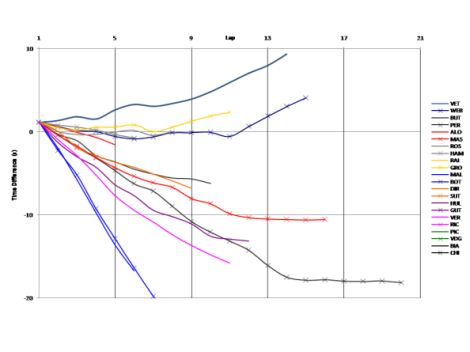Brought to you in partnership with Dr James Beck of IntelligentF1
Yes I know it’s late. But I’ve got there in the end.
There aren’t that many surprises really. The soft tyre is not lasting long at all, and when it is more than a couple of laps old it is slow. The medium tyre is lasting for ever and the degradation is really low. I’m guessing that it won’t do a full race, so that one stoppers aren’t possible, but the return to the days of a single lap (first or last) on the soft tyre is on. Mind you, we had stints of 20 laps, and the tyres were just getting faster – someone could go a long way… And the penalty for going longer is not high unless there is a cliff somewhere. The undercut will be weak.
Seeing as I’m writing after qualifying this week, I would be looking at a stop with a maximum of four to go if I were Webber or Alonso. The Ferraris did run longer on the soft, but the lap times are rubbish – unless things are very different, there is no point going lobg on the soft. Indeed, from Grosjean’s starting point, I would start on softs and be in at the end of the lap in the hope that none of the cars ahead decided that the first lap was the time to bite. Has to be the best shot that they have, especially as there will be a few who opt to start on the mediums.
Vettel’s pace is such that he will be OK whatever he does, although he could be beaten if he gets stuck in traffic, but were I Mercedes i would be concerned – they could lose a lot of time if they stop too late. I think it was brave to qualify both cars on the soft tyre.
Anyway – to the race history chart. There is much less good data for this race. No Raikkonen, Sutil, Gutierrez, Ricciardo – and as I’m late, no Caterhams or Marussias either.

First thing to notice is that the stints get faster as they go. These are medium tyre stints, and the pace increases because the degradation is less that the effect of the fuel load reduction. Massively less. The degradation is usually somewhere around 0.07-0.1s per lap for most tyres in most places, but here 0.03s is somewhere close. So over 20 laps, we have only 0.6s, which makes for a weak undercut, especially as the tyres may not come up to temperature that quickly.
Vettel is quick, Webber is quick and so are Grosjean (a frustrated boy) and Rosberg. Then we have Hamilton, quite a bit slower, and the Ferrari/McLaren/Sauber tussle. Di Resta’s pace suggests that Force India might be part of it, and Vergne is slower although Toro Rosso tend to be quicker come Sunday. Williams are horribly slow.
Numbers from the intelligentF1 model curve fits. As the degradation is low, you will notice that the cars who did shorter stints come out faster than they look on the chart:
- Vettel/Webber fastest
- +0.3s Grosjean
- +0.4s Rosberg
- +1.1s Hamilton
- +1.3s Alonso/Massa/Hulkenburg
- +1.4s Button/Perez
- +1.5s Di Resta
- +2.2s Vergne
- +4.0s Maldonado/Bottas
Whichever way you look at it, the mistake from Lotus in qualifying is a real shame. The black cars look like the biggest threat to the blue ones. Strategy will play it’s part in this one, but it is probably only Webber who can snap the winning streak. But it may not be obvious who is going to finish where until the very final laps…

Very informative. Thanks for this.
Strange, why no mention about Raikkonen, the other Lotus car?
Just guessing that there is not enough data (laps ) for meaningful analysis for Kimi in FP2. He didn’t run any long stints over 10 laps and the times were inconsistent with lot a variarion and after he was almost two seconds behind his teammate in the long runs. So well not much to analyze, maybe he found something and can make it better in the race, the qualification was already improvement over last 3 races, not good but improvement.
I’m still waiting both Lotus drivers to have a good race and fighting for places in top 5. Really hope Romain can show how to improve 15 positions in a race (assuming he can make the first lap)